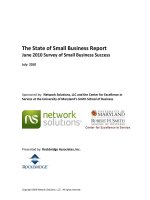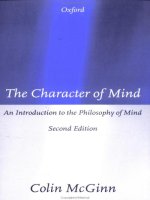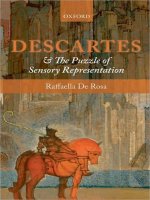- Trang chủ >>
- Khoa Học Tự Nhiên >>
- Vật lý
the dispeller of disputes nagarjunas vigrahavyavartani apr 2010
Bạn đang xem bản rút gọn của tài liệu. Xem và tải ngay bản đầy đủ của tài liệu tại đây (585.64 KB, 153 trang )
The Dispeller of Disputes
This page intentionally left blank
The Dispeller of
Disputes
N¯ag¯arjuna’s Vigrahavy
¯
avartan
¯
ı
Translation and Commentary by
jan westerhoff
2010
Oxford University Press, Inc., publishes works that further
Oxford University’s objective of excellence
in research, scholarship, and education.
Oxford New York
Auckland Cape Town Dar es Salaam Hong Kong Karachi
Kuala Lumpur Madrid Melbourne Mexico City Nairobi
New Delhi Shanghai Taipei Toronto
With offices in
Argentina Austria Brazil Chile Czech Republic France Greece
Guatemala Hungary Italy Japan Poland Portugal Singapore
South Korea Switzerland Thailand Turkey Ukraine Vietnam
Copyright
c
2010 by Oxford University Press, Inc.
Published by Oxford University Press, Inc.
198 Madison Avenue, New York, New York 10016
www.oup.com
Oxford is a registered trademark of Oxford University Press
All rights reserved. No part of this publication may be reproduced,
stored in a retrieval system, or transmitted, in any form or by any means,
electronic, mechanical, photocopying, recording, or otherwise,
without the prior permission of Oxford University Press.
Library of Congress Cataloging-in-Publication Data
Nagarjuna, 2nd cent.
[Vigrahavyavartanı. English]
The dispeller of disputes : Nagarjuna’s Vigrahavyavartanı / Jan Westerhoff.
p. cm.
Translation and commentry by Jan Westerhoff.
Includes bibliographical references.
ISBN 978-0-19-973269-2; 978-0-19-973270-8 (pbk.)
1. Madhyamika (Buddhism)—Early works to 1800.
I. Westerhoff, Jan. II. Title.
BQ2902.E5 2010
294.3’85—dc22 2009023180
987654321
Printed in the United States of America
on acid-free paper
To the best of speakers
This page intentionally left blank
Acknowledgments
I would like to thank the following for their most helpful advice,
pertaining to matters of both philosophy and philology: Kamaleswar
Bhattacharya, Jonardon Ganeri, Jay Garfield, Jowita Kramer, David
Seyfort Ruegg, Mattia Salvini, and Mark Siderits.
This page intentionally left blank
Contents
1. Introduction 3
2. Text: The Dispeller of Disputes 19
3. Commentary 43
3.1. The Status of the Theory of Emptiness [1–4, 21–29] 43
3.1.1. The Madhyamaka Dilemma [1–2, 21–24] 43
3.1.2. The Sound Analogy [3, 25–28] 55
3.1.3. The No-thesis View [4, 29] 61
3.2. Epistemology [5–6, 30–51] 65
3.2.1. Establishing the Epistemic Instruments [5–6, 30–33] 65
3.2.2. The Fire Analogy [34–39] 74
3.2.3. The Epistemic Instruments as Self-established [40–41] 80
3.2.4. Epistemic Instruments and Their Objects [42–48] 82
3.2.5. The Father–Son Analogy [49–50] 88
3.2.6. Summary [51] 90
3.3. Intrinsically Good Things [7–8, 52–56] 94
3.4. Names without Objects [9, 57–59] 104
3.5. Extrinsic Substances [10, 60] 107
3.6. Negation and Existence [11–12, 61–64] 109
3.7. The Mirage Analogy [13–16, 65–67] 116
3.8. Emptiness and Reasons [17–19, 68] 120
3.9. Negation and Temporal Relations [20, 69] 123
3.10. Conclusion [70] 129
Bibliography 135
Index 141
This page intentionally left blank
The Dispeller of Disputes
This page intentionally left blank
1
Introduction
There is no doubt that this treatise of N¯ag¯arjuna
needs to have a wider philosophic audience.
—Matilal 1987: 187
Given the rising interest in Madhyamaka philosophy in the recent
past, this remark by Bimal Matilal is even more true today than
it was over twenty years ago. In fact, “The Dispeller of Disputes,” the
Vigrahavy
¯
avartan
¯
ı, is an ideal companion piece to N¯ag¯arjuna’s main
philosophical treatise, the M
¯
ulamadhyamakak
¯
arik
¯
a or “Fundamental
Verses on the Middle Way.” It covers some important topics that do
not play a big role in this larger work (such as epistemology and the
philosophy of language), and it does so in an unusual question-and-
answer format. In the Vigrahavy
¯
avartan
¯
ı we find N¯ag¯arjuna replying to
a series of specific objections against his theory of universal emptiness
that are raised by both Buddhist and non-Buddhist scholars. As such,
the text is obviously of historical interest, as it gives us an insight into
the kind of philosophical debates conducted in ancient India in the early
days of Madhyamaka thought during the first and second centuries
CE
.
Moreover, and perhaps more important, the Vigrahavy
¯
avartan
¯
ı is also a
tremendously interesting philosophical work. Many key questions and
objections that occur to the reader of N¯ag¯arjuna’s philosophical texts
are set out and discussed in this work, which allows us to gain a view of a
variety of additional facets of the core theory of Madhyamaka. For those
who regard N¯ag¯arjuna’s Madhyamaka as a philosophical system that
4
THE DISPELLER OF DISPUTES
not only was historically very influential but also has a considerable systematic
appeal, the discussion contained in the Vigrahavy
¯
avartan
¯
ı is an invaluable
resource.
History of the Text
The Vigrahavy
¯
avartan
¯
ı consists of seventy verses in ry¯a meter together with
an autocommentary in prose following each verse. The text is divided into two
parts: the first twenty verses (together with the commentary, this is just under
a third of the entire text) present a set of criticisms of N¯ag¯arjuna’s theory of
universal emptiness. In the second part, N¯ag¯arjuna spends the remaining fifty
verses replying to these objections.
Even though the Vigrahavy
¯
avartan
¯
ı was composed in Sanskrit, prior to 1937
no Sanskrit version of the text was available. The first translations into Western
languages were based on Tibetan and Chinese translations of the original San-
skrit. An edition of the Tibetan text based on the versions found in the sNar
thang and Peking bsTan ’gyur was published by Giuseppe Tucci in 1929.
1
The
Tibetan translation of the verses was made in 842
CE
by Jñ¯anagarbha and later
revised by the Kashmiri Jay¯ananda and the Tibetan mDo sde dpal in 1060
CE
.
Jñ¯anagarbha and Ban de rak
.
sita translated the commentary.
2
The Chinese translation is considerably earlier; it was translated by Vi-
mok
.
sa Prajñ¯a
.
r
.
si together with Gautama Prajñ¯aruci in 541
CE
.
3
Susumu Ya-
maguchi published a French translation of the Tibetan version in the Journal
Asiatique of 1929. In the same year, Giuseppe Tucci brought out his Pre-Di
˙
nn
¯
aga
Texts on Logic from Chinese Sources, which contains an English translation of
the Chinese translation. On the whole, the Tibetan translation appears to give
a more precise and philosophically accurate rendering of the Vigrahavy
¯
avartan
¯
ı
than the Chinese. Fortunately, contemporary scholars, unlike Yamaguchi and
Tucci, do not have to rely exclusively on either of these translations any more.
On 28 July 1936, the Indian scholar R¯ahula S¯a
.
nk
.
rty¯ayana discovered
a manuscript of the Sanskrit version of the Vigrahavy
¯
avartan
¯
ı in a bundle
of thirty-nine other Sanskrit texts at Zhwa lu ri phug, a hermitage-like
retreat behind the monastery of Zhwa lu in midwestern Tibet.
4
The manuscript
1. A new edition encorporating the sDe dge and Co ne versions as well is given in Yonezawa (2008).
2. S¯a
.
nk
.
rtyayana (1937: viii).
3. Taish¯o volume 32, number 1631, a newly revised version is in Miyamoto (1999). See also Yamaguchi
(1949).
4. His four expeditions to Tibet in search of Sanskrit mansucripts between the years 1929 and 1938 are
described in S¯a
.
nk
.
rtyayana (1935; 1937; 1938). For the visit to Zhwa lu, see Sa
.
nk
.
rtyayana (1937: 9–15). See also
Steinkellner (2004: 11–17).
INTRODUCTION
5
consists of seven palm leaves inscribed in Tibetan dBu med script. In 1961, the
manuscript was brought to Beijing and later returned to Lhasa, where it is now
kept in the Tibet Museum.
5
The colophon mentions that it was copied by a scribe named Dharmak¯ırti.
Another text from the same bundle from the hand of the same copyist informs
us that it was written down in India while Dharmak¯ırti stayed at the monastery
of Vikrama´sil¯a (in present-day Bihar). The manuscript is not dated, but from
a number of incidental clues S¯a
.
nk
.
rty¯ayana infers that it was probably written
sometime between 1100 and 1120
CE
(about a thousand years after the composi-
tion of the Vigrahavy
¯
avartan
¯
ı ).
6
Recent research by Yoshiasu Yonezawa suggests
a date somewhere between 1090 and 1125.
7
The first edition of this manuscript, based on a handwritten copy made
at Zhwa lu (unlike others, the manuscript was not photographed at the time),
was published in 1937 by S¯a
.
nk
.
rty¯ayana. This appeared as an appendix to the
Journal of the Bihar and Orissa Research Society; it is essentially a copy of the
Sanskrit text with very little change, even though it does take account of the
Tibetan translation.
8
The most useable edition of the Sanskrit is one prepared by Elgin H. John-
ston and Arnold Kunst up to the former’s death in 1942 and published in the
M
´
elanges chinois et bouddhiques in 1947.
9
The great advantage of this edition is
that it tries to improve on the readings of the Sanskrit manuscript, which, unfor-
tunately, is not in very good shape. Though complete, it contains a large num-
ber of omissions, additions, and other mistakes. Johnston and Kunst used the
S¯a
.
nk
.
rty¯ayana edition as the basic text and employed the Tibetan translation in
order to reconstruct the Sanskrit text that the Tibetan translators had in front on
them. Cases of disagreement between the Sanskrit and Tibetan text have been
decided by appeal to the Chinese translation.
10
Johnston and Kunst succeeded
admirably in producing a version of the Sanskrit text “which is readable and as
close to the original as the material permits.”
11
Even though this edition has become the standard resource for scholars,
it contains a variety of philological problems. The most important of these is
5. Steinkellner (2004: 20–21), Yonezawa (2008: 211).
6. S¯a
.
nk
.
rtyayana (1937: viii–ix).
7. Hiraga et al. (2001: 8).
8. Sa
.
nk
.
rty¯ayana’s rendering of the Sanskrit manuscript is not always faithful, though. See Yonezawa (1991).
9. This is now most easily available as a reprint in Bhattacharya et al. (1978).
10. The most important of the rare cases where the Chinese has been followed even though the Sanskrit and
Tibetan agree on a different reading is the final portion of verse 20. Both say “therefore substance does not exist”
(yatah
.
svabhavo ’san, rang bzhin yod min), as it is the opponent speaking; however, it is evident that we should read
with the Chinese “therefore substance exists”.
11. Bhattacharya et al. (1978: 36).
6
THE DISPELLER OF DISPUTES
that Johnston and Kunst had no access to the Sanskrit manuscript itself but had
to work with S¯a
.
nk
.
rty¯ayana’s editio princeps, which is not always accurate in its
rendering of the manuscript. Moreover, the Tibetan text used in their recon-
structions is Tucci’s edition, which only uses two of the available versions.
It is therefore very fortunate that in 2001 Taish¯o University published a
facsimile edition of a collection of Sanskrit manuscripts including the Vigra-
havy
¯
avartan
¯
ı.
12
Even more useful is a transliteration of the Sanskrit manuscript
published by Yonezawa in 2008, which in addition provides an edition of the
Tibetan text based on four different versions. The translation of the Vigra-
havy
¯
avartan
¯
ı provided here is based on the Sanskrit text edited by Yonezawa.
Where this Sanskrit text is defective, however, I follow the Tibetan translation,
which I also do in some instances where it appears to provide a philosophically
more interesting reading.
The Question of Authenticity
The Vigrahavy
¯
avartan
¯
ı belongs to a group of six works known as the Yukti-
corpus (the Tibetan tradition refers to it as the “collection of the six texts on
reasoning” (rigs pa’i tshogs drug). Apart from the M
¯
ulamadhyamakak
¯
arik
¯
a and
the Vigrahavy
¯
avartan
¯
ı, this set of N¯ag¯arjuna’s core philosophical works contains
the “Sixty Stanzas on Reasoning” (Yukti
.
sa
.
st
.
ik
¯
a), the “Seventy Stanzas on Empti-
ness” (
´
S
¯
unyat
¯
asaptati), the “Treatise on Pulverization” (Vaidalyaprakara
.
na), and
the “Precious Garland” (Ratn
¯
aval
¯
ı ).
13
The colophons of the Sanskrit manuscript,
and of the Chinese and the Tibetan translation ascribe the Vigrahavy
¯
avartan
¯
ı to
N¯ag¯arjuna, as do a variety of Madhyamaka authors quoting it, such as Bh¯aviveka,
Candrak¯ırti, and
¯antarak
.
sita.
14
It has to be borne in mind, however, that the au-
thors of the colophons, the scribe Dharmak¯ırti, and the translators, as well as
the later commentators, are separated from N¯ag¯arjuna by several centuries, a
fact that makes their attributions sometimes less certain than we would hope
them to be. This is particularly true in the light of the vast quantity of very dif-
ferent works that have been traditionally ascribed to N¯ag¯arjuna, twenty-four in
the Chinese and as many as 123 in the Tibetan canon. Modern scholars have
12. Hiraga et al. (2001).
13. In some lists the Ratnaval
¯
i is replaced by the no longer extant ∗Vyavah
¯
arasiddhi. See Ruegg 1981: 8.
14. Lindtner (1982a: 70, notes 101–104). If we follow Ruegg (1981: 61) in dating Bhaviveka to 500–570, it
is evident that Yonezawa (2008: 209, note 1) is mistaken in claiming that in Indian sources “no reference to the
Vigrahavyavartan
¯
ı is traceable before Candrakırti (ca. 600–650 A.D.).” This of course only holds if the Bhaviveka
or Bhavya who wrote the ∗Madhyamakaratnaprad
¯
ıpa (which contains the attribution in question) is identical with
the author of the Praj
˜
naprad
¯
ıpa and is not a later author of the same name. On this mattersee Ruegg (1981: 66–67,
note 214), Hiraga et al. (2001: 25, note 3).
INTRODUCTION
7
attempted to categorize these in terms of their possible authenticity. Lindtner
lists thirteen works as “genuine,” including all the works in the Yukti-corpus.
15
Other major Madhyamaka scholars such as David Seyfort Ruegg (as well as all
the translators and editors of the text) also regard the Vigrahavy
¯
avartan
¯
ı as a
work of N¯ag¯arjuna.
16
The most detailed case against attributing the Vigrahavy
¯
avartan
¯
ı to N¯a-
g¯arjuna has been made by Fernando Tola and Carmen Dragonetti in a paper
published in 1998. Their argument focuses on two main issues. First, they
note the relatively close similarity between the Vigrahavy
¯
avartan
¯
ı and the
Vaidalyaprakaran
.
a, a discussion of the categories of the Ny¯aya school only
preseved in Tibetan translation.
17
Since they believe the attribution of the
Vaidalyaprakaran
.
a to N¯ag¯arjuna “is based only in very weak grounds,” they
similary doubt the authenticity of the Vigrahavy
¯
avartan
¯
ı.
18
This is not the place
to assess in detail their criticism of ascribing the Vaidalyaprakaran
.
a to N¯a-
g¯arjuna (although in themselves they do not strike me as any stronger than
those presented against the Vigrahavy
¯
avartan
¯
ı ). I am more concerned with the
methodology of this argument. While one may agree with Tola and Dragonetti’s
claim that “an argument in favour of the authenticity based on the style and
tenets of the work is not decisive by itself as any person belonging to the M¯a-
dhyamika school could have written in the style of the Master,” the reverse of
this procedure, making a claim against the authenticity of a text based on its sim-
ilarity with another one faces its own problems.
19
For it cannot be a sufficient
argument against the authenticity of a text A that it resembles a text B, which,
for the time being, we assume to be not authentic. Otherwise we could use any
Madhyamaka text B demonstrably not by N¯ag¯arjuna to argue that a text A, such
as the M
¯
ulamadhyamakak
¯
arik
¯
a (usually taken to be a work of N¯ag¯arjuna’s by
definition), was not in fact composed by N¯ag¯arjuna, given that it resembles text
B. What the critic would want to show is that the properties which make us
doubt the authenticity of B are precisely the ones that make it resemble A. But
if this is the case, the entire argument from resemblance is superfluous, for
we could just use these properties of A to argue against its authenticity without
bringing in B at all.
Apart from the fact that it is far from obvious that the Vaidalyaprakaran
.
a
(“text B”) is not authentic Tola and Dragonetti do not seem to think that the
15. 1982a: 11.
16. Ruegg (1981: 21–23)
17. Lindtner (1982a: 87) agrees.
18. Tola and Dragonetti (1995: 15). In (1998: 155) they assert that the Vaidalyaprakaran
.
a “cannot be attributed
to N¯agarjuna,” without, however, adducing any new evidence for this stronger claim.
19. For their arguments against the authenticity of the Vaidalyaprakaran
.
a, see Tola and Dragonetti (1995:
7–15).
8
THE DISPELLER OF DISPUTES
properties which should make us doubt the authenticity of the Vaidalyapra-
karan
.
a are the very same ones which should cast suspicion on the author-
ship of the Vigrahavy
¯
avartan
¯
ı (“text A”).
20
For them, the main worry with the
Vaidalyaprakaran
.
a appears to be its “recourse to theories or opinions of the
other schools”, and “its numerous connections with so many texts, schools, and
doctrines.”
21
But this is not the case with the Vigrahavy
¯
avartan
¯
ı, nor do Tola and
Dragonetti claim that it is in their 1998 paper. The main opponent of N¯ag¯ar-
juna in this text, apart from the
bhidharmika metaphysics which consitutes
the background of all his philosophical discussion, is the Ny¯aya epistemology.
And even though the Naiy¯ayikas are not mentioned in central works such as
the M
¯
ulamadhyamakak
¯
arik
¯
a, their presence is hardly a sufficient ground to
question of authenticity of the Vigrahavy
¯
avartan
¯
ı.
This brings us to the second main point of criticism raised by Tola and
Dragonetti against the Vigrahavy
¯
avartan
¯
ı. Their argument is based on the fact
that there are terms which play a prominent role in the Vigrahavy
¯
avartan
¯
ı but are
not found in the M
¯
ulamadhyamakak
¯
arik
¯
a or other prominent members of the
Yukti-corpus, such as the
´
S
¯
unyat
¯
asaptati and Yukti
.
sa
.
s
.
tik
¯
a, and that illustrative ex-
amples found in these texts are used in a different way in the Vigrahavy
¯
avartan
¯
ı.
The terms “epistemic instrument” (pram
¯
a
.
na) and “epistemic object” (prameya)
are not mentioned in the M
¯
ulamadhyamakak
¯
arik
¯
a; in fact, there is very little
epistemological discussion in this text at all. The example of the magically cre-
ated persons mentioned in verse 23 of the Vigrahavy
¯
avartan
¯
ı is also found in the
´
S
¯
unyat
¯
asaptati,
but
there it is not used to argue for the causal efficiency of the
agent. Tola and Dragonetti list numerous examples of this sort that are very in-
teresting from a comparative perspective but do not present a strong case against
the claim that the Vigrahavy
¯
avartan
¯
ı was composed by N¯ag¯arjuna. For this argu-
ment to work, one would have to assume that an author generally discusses the
same problems in all his works and that he generally uses examples in the same
way. A brief look at any philosopher’s literary output, past or present, will con-
vince us how unrealistic his assumption is. Not only do philosophers treat differ-
ent topics in different works but also their works sometimes disagree with each
other (if this disagreement is diachronic, we generally regard it as philosophi-
cal development). In the present discussion, disagreements between the Vigra-
havy
¯
avartan
¯
ı and N¯ag¯arjuna’s other main works are not even an issue. On the
whole, the philosophical system presented is quite uniform. But if even the mere
fact that different works deal with different aspects of the same theory are seen
as sufficient to question the authenticity of some of them, one wonders what
20. Tola andDragonetti (1995: 8).ThemajorityofmodernMadhyamaka scholars accept theVaidalyaprakaran
.
a
asoneofNagarjuna’s works.See,forexample,Kajiyama (1965: 130), Ruegg (1981: 19, 21), Lindtner (1982a: 11, 87).
21. Tola and Dragonetti (1995: 14).
INTRODUCTION
9
would happen if we ever encounter the ancient Indian equivalent of the Tracta-
tus and the Philosophical Investigations. Considering the diverging philosophical
views discussed in each, we would surely have to assume that they were written
by two different people who just happened to share the name Wittgenstein.
Structure of the Vigrahavy
¯
avartan
¯
ı
The structure of the Vigrahavy
¯
avartan
¯
ı is certainly peculiar. The objections are
listed one after the other in the first part of the text, followed by all the replies in
the second half. This makes it necessary to repeat nearly all of the first twenty
verses in the second half in order to indicate which reply is aimed at which
criticism. We do wonder why N¯ag¯arjuna did not choose the far simpler method
of simply listing one objection, followed by the reply, then another objection
followed by its reply, and so on. It has been suggested that reason for this is that
the first twenty verses were not in fact written by N¯ag¯arjuna at all, so that the
Vigrahavy
¯
avartan
¯
ı is really a conjunction of two texts by two different authors.
22
But this does not appear to explain much, either. For if the Vigrahavy
¯
avartan
¯
ı
was really written as the refutation of a specific treatise critical of Madhyamaka
thought, it would have been more straightforward for N¯ag¯arjuna to respond di-
rectly to this text and to quote the verses he sets out to refute at the respective
parts of his discussion, very much as he does in the second part of the Vigra-
havy
¯
avartan
¯
ı. By quoting just five more verses in this way, N¯ag¯arjuna would
have incorporated all of the root verses of the supposed anti-Madhyamaka trea-
tise into his text, thereby making it superfluous to list them once more at the
beginning of his treatise.
In addition, conceiving of the first twenty verses as an independent treatise
raises about as many questions as it is supposed to answer. These verses do not
set out a connected argument, but appear rather like a list of various criticisms
one could raise against the M¯adhyamikas. The perspectives from which these
objections come are very diverse, so that it is difficult to see what the views of
the supposed author of this treatise could possibly have been.
It is perhaps easier to understand the peculiarities of the Vigrahavy
¯
avarta-
n
¯
ı ’s arrangement by asking ourselves why N¯ag¯arjuna saw it necessary to keep
the majority of the objections together in one section of his text.
23
Perhaps a list
22. Tola and Dragonetti (1998: 154–155).
23. The opponent does speak occasionaly in the second half (for example in the autocommentary on verses
33, 37, 40, and 69). This may be seen as evidence for a certain autonomy of the first part, which would explain why
not all of the objections have been included here. It would imply that Nagarjuna drew a distinction between the
objections somehow transmitted to him as belonging to one group, discussed in the first part, and other, merely
hypothetical, objections he considered as part of his reply and included in the second part.
10
THE DISPELLER OF DISPUTES
of disputed topics (the vigraha the title refers to) based on a variety of presup-
positions (both Buddhist and non-Buddhist) had been circulating and tempted
him to respond. If this list was well known enough for it to be recognizable but
not detailed enough to serve as a basis for a treatise refuting it, the arrangement
of the text might appear a bit more reasonable. By keeping the structure of the
list intact, the aim and justification of his Madhyamaka countercritique would
be evident; at the same time, the objections it contained had to be enlarged in
order to present a satisfactory and determinate target. N¯ag¯arjuna therefore for-
mulated the list of objections as the first part of the Vigrahavy
¯
avartan
¯
ı in the
same verse-plus-commentary form we find in the second part. This then made
it necessary to quote a substantial amount of the verses from the first part in the
second in order to match objections with replies.
The translation presented here follows the structure of the Vigrahavy
¯
avar-
tan
¯
ı. For the commentary, however, I have chosen a different approach. The
commentary incorporates the entire text of the Vigrahavy
¯
avartan
¯
ı.
24
It is, how-
ever, rearranged in such a way that the objections from the first part are followed
directly by the respective replies from the second part. In this way verses 1 and 2,
for example, are not followed by verse 3, but by verses 21 to 24, which answer the
objection formulated there. In this way the Vigrahavy
¯
avartan
¯
ı is easier to follow
as a philosophical text, since the opponent’s objection and N¯ag¯arjuna’s reply
illuminate one another. Moreover, this rearrangement allows us to divide the
text into different sections of objections and replies that deal with different is-
sues. It is thereby easier to see which groups of problems the Vigrahavy
¯
avartan
¯
ı
deals with.
In the translation I have attempted to provide English equivalents of all
the Indian philosophical terms and have only given the Sanskrit equivalent
in brackets at times when I considered it to be indispensable. Translations of
technical philosophical terms are, of course, always problematic, as it is usu-
ally not possible to find a precise conceptual equivalent in the target language.
The most obvious example in the present text is the central term svabh
¯
ava, here
translated as “substance.” In an earlier discussion of N¯ag¯arjuna’s thought I
left this term untranslated, arguing that none of the potential equivalents from
Western philosophy cover all the dimensions of its meaning.
25
While I still be-
lieve this to be the case, the use of the term svabh
¯
ava in the Vigrahavy
¯
avartan
¯
ı
shows a considerable amount of overlap with the term “substance,” used to
24. Apart from the references to the objections from the first twenty verses (“Concerning what you said ear-
lier [in verse x] we reply:”) which are superfluous in the rearrangement. I also left out the formulaic phrases con-
necting some of the verses (kim
.
canyat, “and, moreover, another issue”; atra br
¯
umah
.
“on this point we reply,” etc.)
25. Westerhoff (2009a: 4).
INTRODUCTION
11
refer to an entity not depending on anything else.
26
Translating it in this way
therefore keeps the translation free from unfamiliar technical terms and neolo-
gisms of “Buddhist Hybrid English” (such as “inherent existence,” “own be-
ing”), while also giving a sufficiently accurate representation of N¯ag¯arjuna’s
arguments.
27
Synopsis of the Argument
In the commentary I divided the Vigrahavy
¯
avartan
¯
ı into ten sections.
1. The Status of the Theory of Emptiness [1–4, 21–29]
N¯ag¯arjuna begins his treatise by presenting an objection that I have called the
“Madhyamaka dilemma.” Since the Madhyamaka sets out to defend the thesis
of universal emptiness, which argues that all things without exception lack sub-
stance or svabh
¯
ava, the statement of the thesis will lack substance as well. But
this leads to a problem, the opponent says. For how could a wholly insubstantial
thesis be effective as an argument against any philosophical proposition? But
if it is not effective in this way, it also cannot refute the substantialist’s view
that substances do exist and is therefore argumentationally powerless. This is
the first horn of the dilemma. On the other hand, if it does have argumentative
power it must be substantial, so that the universal thesis that everything lacks
substance has to be false. This is the second horn.
N¯ag¯arjuna responds to this problem by embracing the first horn. Since the
thesis of universal emptiness is causally produced, it is itself empty. The the-
sis therefore holds with full generality. As the examples used by the opponent
show, he has misunderstood “empty” to mean “non-existent,” which explains
why he questions the ability of empty objects to accomplish anything. But N¯a-
g¯arjuna states explicitly that empty objects are causally efficacious. In fact, as
being empty means being arisen in dependence on causes and conditions, this
emptiness is a precondition for objects’ being able to enter into a causal nexus
in turn. To this extent, the first horn of the dilemma is not an unacceptable
consequence but an essential part of the theory of emptiness.
The causal efficacy of empty objects is illustraded by N¯ag¯arjuna using sev-
eral examples. The most mundane ones are those of things like chariots, pots,
and so forth, which are dependently originated (and therefore empty) while
26. ‘Substance’ is unfortunately also commonly used to translate the term dravya. For an overview of the dif-
ferent conceptual dimensions of the notion of svabhava in Nagarjuna’s thought, see Westerhoff (2009a: chapter 2).
27. Westerhoff (2009a: Introduction, chapter 2).
12
THE DISPELLER OF DISPUTES
at the same time obviously capable of fulfilling a variety of functions. More
intriguingly, he describes several cases where causal interaction happens be-
tween illusory entities, such as various phantoms conjured up by an illusionist.
Nobody will want to hold that these phantoms exist substantially, yet they inter-
act in a regular, causal manner.
This section also contains the famous twenty-ninth verse in which N¯ag¯arju-
na claims that he does not have any thesis himself. This does not amount to the
paradoxical claim of someone asserting that he is not asserting anything. What
N¯ag¯arjuna wants to say is that he does not hold any substantially existent thesis,
that is, any thesis which is to be supplied with a realist semantics that spells out
meaning and truth in terms of correspondence with a mind-independent real-
ity. The M¯adhyamika will have to interpret his statements in terms of a purely
convention-based semantics in order to avoid reintroducing substantially exis-
tent objects by the back door.
2. Epistemology [5–6, 30–51]
This is by far the longest of all sections in the Vigrahavy
¯
avartan
¯
ı. Considering
only the amount of text it occupies, one might think that it took N¯ag¯arjuna
twenty-one verses in order to reply to an objection described in two. This, how-
ever, is not the case.
The opponent is still worried about how empty things can be functionally
efficient, and argues that the four instruments of epistemic access to the world
traditionally accepted—perception, inference, testimony, and likeness—cannot
provide any basis for our knowledge of the world if they, like everything else,
are regarded as empty.
N¯ag¯arjuna does not spend the remainder of the section replying to this
by repeating his claim for the equivalence of emptiness and functionality just
made. Instead, he presents a comprehensive critique of the epistemology his
Ny¯aya opponent defends. First, N¯ag¯arjuna points out that if we try to justify our
knowledge of the world by saying that we acquired it by accepted epistemic in-
struments, we have just pushed the problem back one step, for we now have to
justify the instruments.
Two replies suggest themselves here: first, we could say that each epistemic
instrument is established by another, distinct epistemic instrument, or that they
do not need any establishement at all. In the first case we are faced with an
infinite regress, since each instrument requires a new instrument to establish
it. That we need infintely many epistemic instruments in this way is not the
greatest problem here (one might want to hold that the epistemic instruments
INTRODUCTION
13
establish each other in a circular fashion, so that only finitely many of them
would be required), but rather the fact that we never reach any foundation for
our epistemological theory, that is, something which tells us why what we regard
to be epistemic instruments really are such instruments.
The second reply, arguing that the epistemic instruments do not need to be
established in turn, is not very attractive because the Naiy¯ayika wants to claim
that all we know is known by some epistemic instrument. But knowing that the
epistemic instruments really are the instruments they seem to be then would
be something that we could not know by these very instruments.
The opponent suggests an alternative that is supposed to get around these
problems. In the same way in which fire illuminates both other things as well
as itself, he argues, the epistemic instruments can establish both: the things
to be known as well as themselves. N¯ag¯arjuna uses the next six verses (34–39)
in order to defuse the force of this example by arguing that fire does not in
fact illuminate itself. Should the opponent still hold on to the thesis of the
self-establishment of the epistemic instruments despite the unsatisfactory fire
example, N¯ag¯arjuna continues in verse 40, there is yet another problem in store.
For how do we know that the self-establishment of the epistemic instruments
really is an indication of epistemic veracity and not of something else? We can
only do so by looking at the objects thus apprehended. But if we have to take
the epistemic objects into account, the claim of self-establishment loses its
basis.
The next seven verses (42–48) take a closer look at the role of the objects
in the establishment of the epistemic instruments. Establishing the epistemic
instruments on the basis of the objects does not seem to be a very promising
route. After all, the instruments are supposed to be what provides us with knowl-
edge of the objects. The objects cannot really be taken to be independent of the
epistemic instruments, either, since then there would be no point in having the
instruments to establish the objects in the first place. Finally, if the epistemic
instruments and objects are mutually dependent on each other, we do not reach
a foundation for our epistemology.
N¯ag¯arjuna therefore concludes that the we have to give up the idea that epis-
temic instruments and objects are epistemic instruments and objects intrinsi-
cally, that is that there is a collection of objects “out there,” the existence of which
is independent of our epistemic endeavors, and a set of epistemic detectors “in
here” that exist independent of the objects they detect. It therefore becomes ev-
ident that it is in no way a drawback that we have to regard the epistemic in-
struments as empty, as the opponent suggested at the beginning of this section.
Given the problems of the alternative picture he provides, this is in fact the
preferable option.
14
THE DISPELLER OF DISPUTES
3. Intrinsically Good Things [7–8, 52–56]
In the preceding section, the opponent argued from the perspective of Ny¯ayaepis-
temology. Now we see him take the standpoint of a Buddhist, probably that of an
bhidharmika. The opponent suggests that the Buddha’s teaching implies that
at least some things must exist substantially, namely, those which are regarded
as fundamentally bad (such as suffering) and those which are regarded as fun-
damentally good (such as liberation). These are not just bad or good because we
think them to be that way, but they have these qualities by their very nature, and
exist independent of anything else. By denying the substantial existence of these
properties, N¯ag¯arjuna invalidates core assumptions of the Buddhist doctrine.
N¯ag¯arjuna replies by pointing out that in fact matters are the other way
around. It is the opponent who cannot make sense of the Buddhist path. For
if suffering and liberation existed as substances, independent of other things,
it would be impossible ever to eradicate suffering or bring about liberation,
since they would be outside of the network of causes and conditions. This is
another manifestation of the claim that the theory of emptiness does not con-
tradict causal efficiency but is rather one of its essential preconditions.
4. Names without Objects [9, 57–59]
The critcism raised here has to be understood against the background of a
Ny¯aya-style realist semantics. According to this theory, simple names and pred-
icates of a language acquire their meaning by connecting with things and prop-
erties in the world. But then, if N¯ag¯arjuna denies the existence of substance, he
is faced with the problem that the term “substance” only gets its meaning by
picking out a corresponding thing in the world. In this case his assertion must
be wrong, as we can argue on semantic grounds that substance must exist.
It is indeed not very surprising that we run into problems if we couple
a semantic theory like the one defended by the Naiy¯ayika, which postulates a
foundation of language in the world, with an anti-foundationalist position like
N¯ag¯arjuna’s theory of emptiness. But there is no reason why N¯ag¯arjuna should
have to adopt the Ny¯aya theory of language. Taking into account the realist as-
sumptions built into this semantics, he would be ill-advised to do so. But if this
semantics is rejected, the criticism raised will disappear.
5. Extrinsic Substances [10, 60]
But perhaps there is a way of squaring a realist semantics with the theory
of emptiness. We could assume that substance does exist, so that the term









